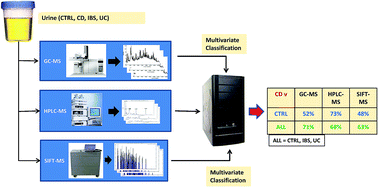Comparison of GC-MS, HPLC-MS and SIFT-MS in conjunction with multivariate classification for the diagnosis of Crohn's disease in urine†
Abstract
The developed world has seen an alarming increase in the incidence of gastrointestinal diseases, among the most common of which is Crohn's disease (CD) in the young. The current “gold standard” techniques for diagnosis are often costly, time consuming, inefficient, invasive, and offer poor sensitivities and specificities. This paper compares the performances of three hyphenated instrumental techniques that have been suggested as rapid methods for the non-invasive diagnosis of CD from urine. These techniques are gas chromatography-mass spectrometry (GC-MS), high performance liquid chromatography-mass spectrometry (HPLC-MS) and selected ion flow tube mass spectrometry (SIFT-MS). Each of these techniques is followed by multivariate classification to provide a diagnosis based on the acquired data. The most promising results for potentially diagnosing CD was via HPLC-MS. An overall classification accuracy of 73% (74% specificity; 73% sensitivity) was achieved for differentiating CD from healthy controls, statistically significant at 95% confidence.


 Please wait while we load your content...
Please wait while we load your content...